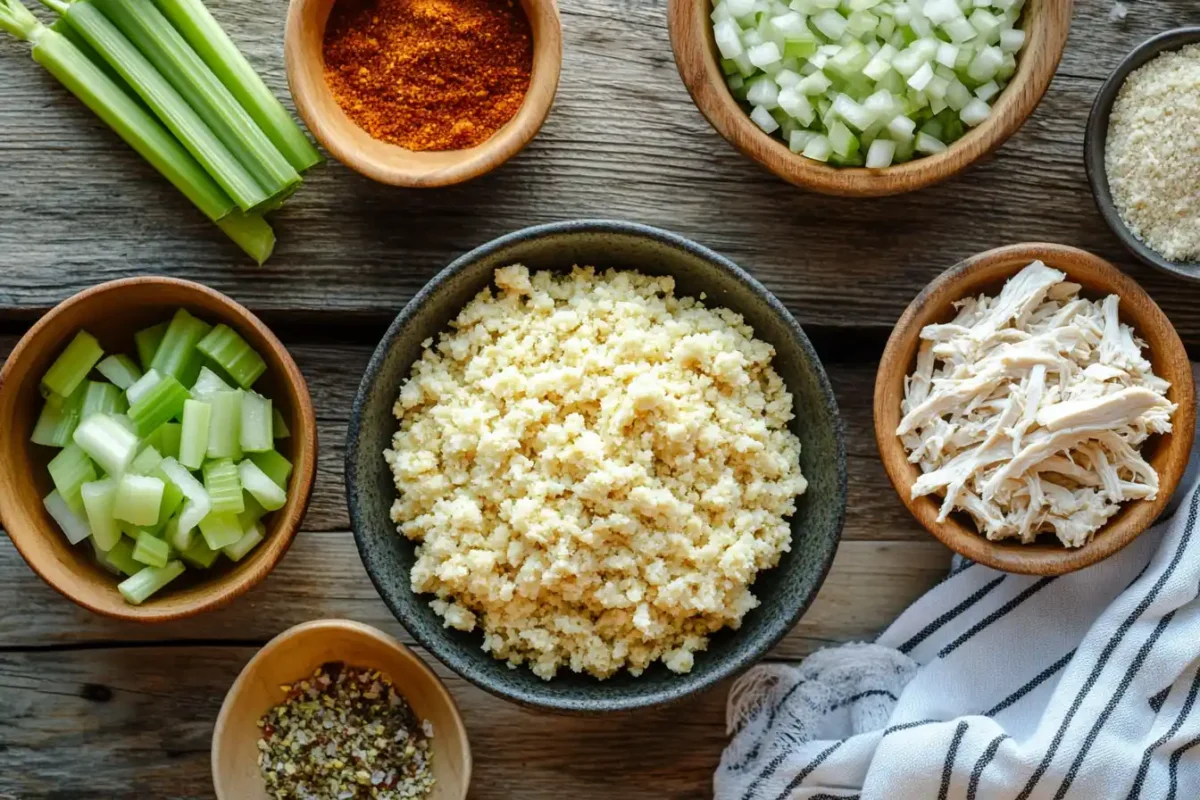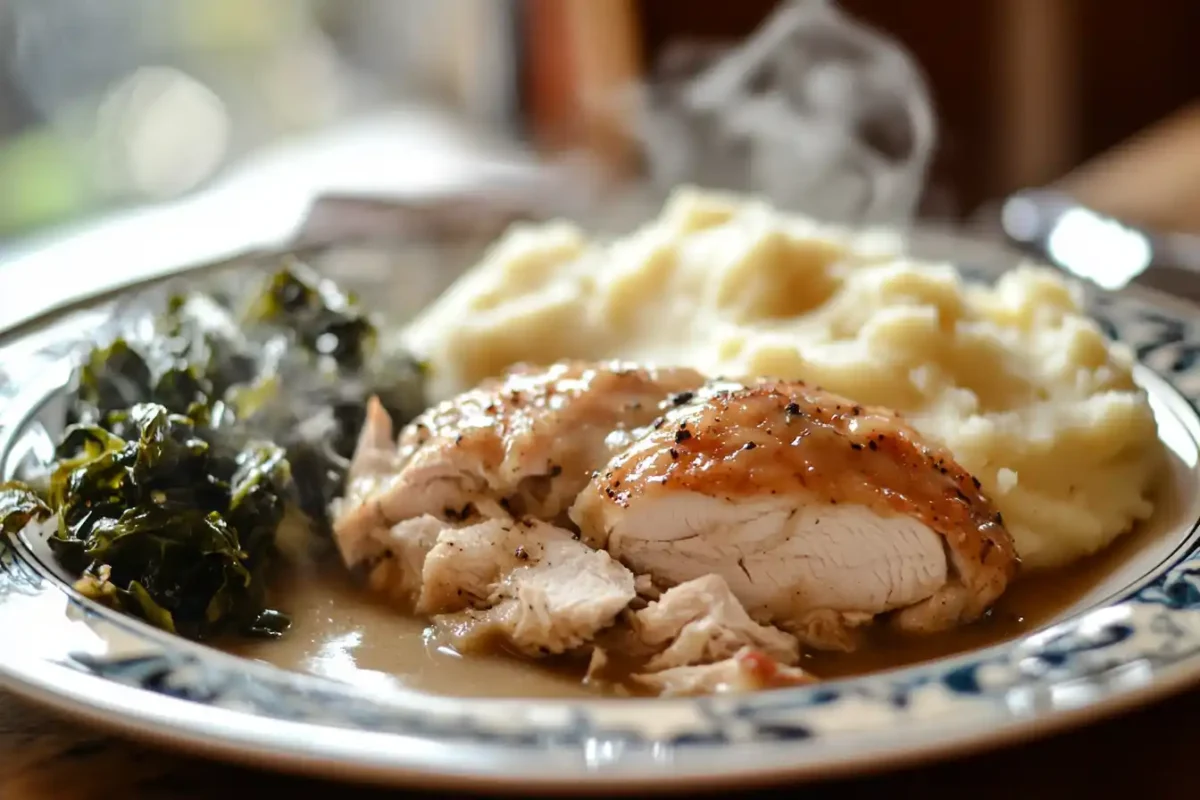Chicken and Dressing
I still remember the first time my grandmother taught me how to make chicken and dressing. The warm aroma of freshly baked cornbread mixed with the rich scent of roasted chicken filled the air, creating a feeling of comfort and nostalgia. This dish isn’t just food it’s a memory, a tradition, and a way to bring people together.
Whether you’re preparing it for Thanksgiving, Sunday dinner, or just craving a hearty meal, this recipe is a must-know. But what exactly is chicken and dressing made of? Let’s break it down step by step and uncover the magic behind this Southern classic.
What is Chicken and Dressing?
Chicken and dressing is a beloved Southern dish that combines shredded chicken with a flavorful, seasoned cornbread-based dressing. Unlike stuffing, which is cooked inside the turkey, dressing is baked separately in a dish. The result? A moist, savory, and comforting side that pairs perfectly with turkey, gravy, and cranberry sauce.
History and Origins of Chicken and Dressing
This dish has deep roots in Southern and African American cuisine. Originally, cornbread dressing was a way to use up stale bread while adding flavor with fresh herbs and homemade broth. Over time, families personalized their recipes, adding ingredients like celery, onions, and even sausage.
Why is Chicken and Dressing Popular?
There’s a reason this dish has stood the test of time. It’s:
- Comforting: The warm, soft texture and rich flavors make it a cozy meal.
- Easy to Make: With simple ingredients and a one-pan approach, anyone can master it.
- Perfect for Gatherings: Whether it’s Thanksgiving or Sunday dinner, it’s a crowd-pleaser.
Key Ingredients in Chicken and Dressing
To make a delicious chicken and dressing recipe, you need a few essential ingredients:
| Ingredient | Quantity | Purpose |
|---|---|---|
| Cooked Chicken (shredded) | 3 cups | Main protein, adds rich flavor |
| Cornbread (crumbled) | 4 cups | Base of the dressing, absorbs flavors |
| Chicken Broth | 3 cups | Keeps the dressing moist and flavorful |
| Onion (chopped) | 1 medium | Adds depth of flavor |
| Celery (chopped) | 2 stalks | Provides crunch and aroma |
| Eggs (beaten) | 2 large | Helps bind ingredients together |
| Butter (melted) | 1/2 cup | Enhances richness |
| Poultry Seasoning | 1 tbsp | Gives the classic Thanksgiving flavor |
| Sage (dried) | 1 tsp | Adds an earthy, herby taste |
| Salt & Pepper | To taste | Enhances all flavors |
Chicken: Choosing the Right Type
You can use baked, boiled, or rotisserie chicken. Some people prefer dark meat because it’s juicier, but a mix of white and dark meat creates the best balance.
Bread for Dressing: Cornbread vs. White Bread
Traditionally, Southern-style dressing uses cornbread. However, some recipes mix in white bread or biscuits for a fluffier texture.
Essential Herbs and Seasonings
Poultry seasoning, sage, thyme, and black pepper are must-haves for that classic flavor. Some people also add garlic powder or cayenne for a bit of a kick.
Broth and Moisture: The Secret to Flavor
Homemade chicken broth is best, but store-bought works too. The key is to add just enough so the dressing is moist but not soggy.
Optional Add-ins for Extra Flavor
- Sausage: Adds a smoky, savory taste.
- Hard-boiled eggs: Some families swear by them.
- Oysters: A classic addition in some coastal regions.
- Jalapeños: For those who like a spicy kick.
Nutrition Facts
| Serving Size | 1 cup |
|---|---|
| Calories | 350 kcal |
| Protein | 18g |
| Carbohydrates | 30g |
| Fat | 18g |
| Sodium | 780mg |
How to Make Chicken and Dressing – Step-by-Step Recipe
Step 1: Preparing the Chicken
You can use any cooked chicken for this recipe, but here’s the best way to prepare it:
- **Boiling Method:** Add 3-4 chicken breasts (or a mix of thighs and breasts) to a large pot. Cover with water, add a teaspoon of salt, and simmer for 30-40 minutes until fully cooked.
- **Baking Method:** Preheat oven to 375°F (190°C). Place seasoned chicken in a baking dish, cover with foil, and bake for 35-40 minutes.
- **Rotisserie Shortcut:** If you’re short on time, a store-bought rotisserie chicken works great!
Once the chicken is fully cooked, let it cool slightly and shred it into bite-sized pieces.
Step 2: Making the Cornbread for Dressing
While the chicken is cooking, prepare the cornbread:
Classic Cornbread Recipe
| Ingredient | Quantity |
|---|---|
| Cornmeal | 1 cup |
| All-purpose flour | 1/2 cup |
| Baking powder | 1 tsp |
| Salt | 1/2 tsp |
| Egg | 1 large |
| Milk | 1 cup |
| Butter (melted) | 2 tbsp |
- Preheat oven to 375°F (190°C).
- In a bowl, mix all dry ingredients.
- Whisk the egg, milk, and melted butter together, then add to the dry ingredients.
- Pour into a greased baking dish and bake for 20-25 minutes.
- Let cool, then crumble it into small pieces.
Step 3: Sautéing the Vegetables
In a skillet, melt 1/2 cup of butter and sauté:
- 1 medium onion (chopped)
- 2 stalks of celery (chopped)
- Optional: 1/2 cup of diced bell peppers for extra flavor
Cook for about 5-7 minutes until soft and fragrant.
Step 4: Mixing the Dressing Ingredients

Now, it’s time to bring everything together!
- In a large bowl, combine the crumbled cornbread, shredded chicken, and sautéed vegetables.
- Add 3 cups of **chicken broth** to moisten the mixture.
- Stir in 2 beaten eggs to help bind the dressing.
- Season with 1 tbsp poultry seasoning, 1 tsp dried sage, salt, and black pepper to taste.
- Mix well until everything is evenly combined.
Step 5: Baking the Dish to Perfection
- Preheat oven to 375°F (190°C).
- Grease a baking dish and pour in the mixture, spreading it evenly.
- Bake uncovered for 35-45 minutes, until golden brown on top.
- Let cool for 10 minutes before serving.
Common Problems and How to Fix Them
Why is My Dressing Too Dry?
Solution: Add more chicken broth before baking. If already baked, pour warm broth over the top and cover with foil to soften.
How to Avoid a Mushy Dressing
Solution: Use day-old cornbread to prevent excess moisture. Also, avoid adding too much broth.
Preventing a Bland Taste
Solution: Increase seasonings! Poultry seasoning, sage, and butter enhance the flavor. Taste before baking and adjust as needed.
How to Achieve the Perfect Texture
Solution: Balance moisture. Dressing should be wet but not soupy. Stir well so that all ingredients blend evenly.
Variations of Chicken and Dressing
While the classic **chicken and dressing recipe** is already delicious, there are many ways to put a unique twist on it. Here are some exciting variations to try:
Southern-Style Chicken and Dressing
- Uses only cornbread for a denser, more traditional texture.
- Includes extra sage and black pepper for a bold flavor.
- Often served with giblet gravy for extra richness.
Slow Cooker Chicken and Dressing
- Perfect for busy days just mix the ingredients and let it cook!
- Set to **low for 6-7 hours** or **high for 3-4 hours** until fully cooked.
- Keeps the dressing extra moist and flavorful.
Gluten-Free Chicken and Dressing
- Swap regular cornbread with gluten-free cornbread or almond flour-based bread.
- Use gluten-free chicken broth and seasoning blends.
- Same delicious flavor without the gluten!
Spicy Jalapeño Chicken and Dressing
- Add 1-2 finely chopped jalapeños for a spicy kick.
- Mix in a pinch of cayenne pepper for extra heat.
- Pairs well with cool, creamy coleslaw.
Tips for Making the Best Chicken and Dressing
Want to take your **chicken and dressing recipe** to the next level? Follow these expert tips!
Use Homemade Broth for the Best Flavor
Homemade chicken broth is richer and more flavorful than store-bought versions. Simply simmer leftover chicken bones, carrots, celery, and onions for a few hours to create a delicious broth.
Don’t Overmix the Dressing
Overmixing can make the dressing too dense. Stir just enough to combine the ingredients without making it mushy.
Let the Dressing Rest Before Serving
After baking, let the dish sit for 10-15 minutes. This allows flavors to meld together and makes serving easier.
Taste Before Baking
Want to avoid bland dressing? Taste the mixture before baking and adjust seasonings as needed.
Add a Crispy Top Layer
For a golden, crispy top, brush melted butter on the dressing before baking or broil for the last 5 minutes.
How to Store and Reheat Chicken and Dressing
Storing Leftovers
- Refrigerate: Store in an airtight container for up to **4 days**.
- Freeze: Wrap tightly in plastic wrap and freeze for up to **3 months**.
Reheating Instructions
- Oven: Preheat to 350°F (175°C) and bake for **20-25 minutes**, covered with foil.
- Microwave: Heat individual servings on high for **1-2 minutes**, adding a little broth if needed.
Perfect Pairings: What to Serve with Chicken and Dressing
This dish pairs well with classic Southern sides! Try serving it with:
- Giblet Gravy: Adds a rich, creamy texture.
- Collard Greens: A flavorful, healthy side.
- Mashed Potatoes: Creamy and comforting.
- Cranberry Sauce: Balances the savory flavors with a hint of sweetness.
Frequently Asked Questions (FAQs)
Can I Use Store-Bought Cornbread?
Yes! If you’re short on time, store-bought cornbread works well. Just make sure it’s not too sweet, as that can alter the dish’s flavor.
How Do I Make It Without Chicken?
For a vegetarian version, swap chicken with mushrooms or lentils and use vegetable broth instead.
What’s the Difference Between Dressing and Stuffing?
Stuffing is typically cooked inside a turkey, while dressing is baked separately in a dish. The flavors are similar, but the textures can differ.
Can I Make This Dish Ahead of Time?
Absolutely! You can assemble the dressing a day in advance and refrigerate it. When ready to bake, just add a little extra broth and bake as usual.
How Do I Make It Extra Moist?
Use an extra cup of broth and cover the dish with foil while baking. This traps moisture and keeps the dressing soft.
Explore More Delicious Recipes
Final Thoughts – Try This Classic Recipe Today!

Now that you know how to make the perfect **chicken and dressing recipe**, it’s time to get cooking! Whether you keep it classic or try a fun variation, this dish is guaranteed to be a hit.
We’d love to hear from you! **How do you make your chicken and dressing?** Share your tips in the comments and follow us for more delicious recipes.
Happy cooking with Rita Chef ❤️!
Print
What is Chicken and Dressing Made Of?
- Total Time: 1 hour 5 minutes
- Yield: 8 servings
Description
This classic chicken and dressing recipe is a rich and comforting Southern favorite made with shredded chicken, crumbled cornbread, and flavorful herbs. Perfect for holidays, family gatherings, or cozy dinners, this dish is moist, delicious, and easy to prepare. Serve it with giblet gravy and your favorite Southern sides for a complete meal.
Ingredients
For the Chicken
Cooked and shredded chicken – 3 cups
Salt – 1 teaspoon
Black pepper – 1 teaspoon
For the Cornbread
Cornmeal – 1 cup
All-purpose flour – 1/2 cup
Baking powder – 1 teaspoon
Salt – 1/2 teaspoon
Egg – 1 large
Milk – 1 cup
Melted butter – 2 tablespoons
For the Dressing
Crumbled cornbread – 4 cups
Chopped onion – 1 medium
Chopped celery – 2 stalks
Chicken broth – 3 cups
Beaten eggs – 2 large
Melted butter – 1/2 cup
Poultry seasoning – 1 tablespoon
Dried sage – 1 teaspoon
Salt and pepper – To taste
Instructions
Prepare the Chicken
Boil or bake the chicken until fully cooked, then shred into bite-sized pieces
Season with salt and black pepper and set aside
Make the Cornbread
Preheat oven to 375°F (190°C)
In a bowl, mix cornmeal, flour, baking powder, and salt
In another bowl, whisk together egg, milk, and melted butter, then combine with dry ingredients
Pour into a greased baking dish and bake for 20-25 minutes until golden brown
Let cool, then crumble into small pieces
Sauté the Vegetables
Melt butter in a pan over medium heat
Add chopped onions and celery, then cook for about 5 minutes until soft
Mix the Dressing
In a large bowl, combine crumbled cornbread, shredded chicken, and sautéed vegetables
Add chicken broth, beaten eggs, melted butter, poultry seasoning, sage, salt, and pepper
Mix gently until well combined but do not overmix
Bake the Dressing
Preheat oven to 375°F (190°C)
Grease a baking dish and pour the mixture, spreading evenly
Bake uncovered for 35-45 minutes until golden brown on top
Let cool for 10 minutes before serving
Notes
For extra moisture, add an extra cup of chicken broth before baking
Taste the dressing mixture before baking and adjust seasonings as needed
For a crispy top, brush melted butter on the dressing before baking
- Prep Time: 20 minutes
- Cook Time: 45 minutes
- Category: Main Dish
- Method: Baking
- Cuisine: Southern
Nutrition
- Serving Size: 1 cup
- Calories: 350 kcal
- Sugar: 2g
- Sodium: 780mg
- Fat: 18g
- Saturated Fat: 8g
- Unsaturated Fat: 9g
- Trans Fat: 0g
- Carbohydrates: 30g
- Fiber: 3g
- Protein: 18g
- Cholesterol: 95mg

